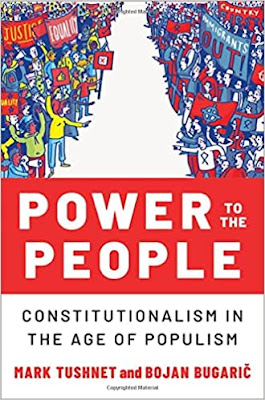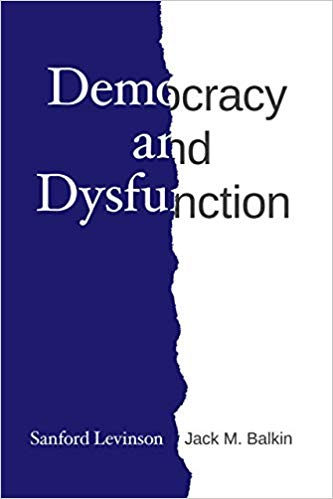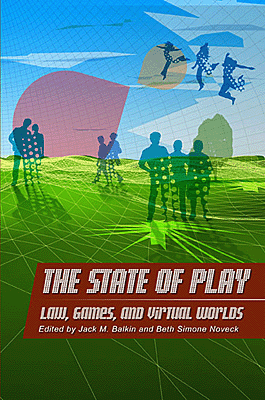Balkinization
an unanticipated consequence of
Jack M. Balkin
Balkinization Symposiums: A Continuing List
E-mail:
Jack Balkin:
jackbalkin at yahoo.com
Bruce Ackerman
bruce.ackerman at yale.edu
Ian Ayres
ian.ayres at yale.edu
Corey Brettschneider
corey_brettschneider at brown.edu
Mary Dudziak
mary.l.dudziak at emory.edu
Joey Fishkin
joey.fishkin at gmail.com
Heather Gerken heather.gerken at yale.edu
Abbe Gluck abbe.gluck at yale.edu
Mark Graber
mgraber at law.umaryland.edu
Stephen Griffin
sgriffin at tulane.edu
Jonathan Hafetz
jonathan.hafetz at shu.edu
Jeremy Kessler
jkessler at law.columbia.edu
Andrew Koppelman
akoppelman at law.northwestern.edu
Marty Lederman
msl46 at law.georgetown.edu
Sanford Levinson
slevinson at law.utexas.edu
David Luban
david.luban at gmail.com
Gerard Magliocca
gmaglioc at iupui.edu
Jason Mazzone
mazzonej at illinois.edu
Linda McClain
lmcclain at bu.edu
John Mikhail
mikhail at law.georgetown.edu
Frank Pasquale
pasquale.frank at gmail.com
Nate Persily
npersily at gmail.com
Michael Stokes Paulsen
michaelstokespaulsen at gmail.com
Deborah Pearlstein
dpearlst at yu.edu
Rick Pildes
rick.pildes at nyu.edu
David Pozen
dpozen at law.columbia.edu
Richard Primus
raprimus at umich.edu
K. Sabeel Rahmansabeel.rahman at brooklaw.edu
Alice Ristroph
alice.ristroph at shu.edu
Neil Siegel
siegel at law.duke.edu
David Super
david.super at law.georgetown.edu
Brian Tamanaha
btamanaha at wulaw.wustl.edu
Nelson Tebbe
nelson.tebbe at brooklaw.edu
Mark Tushnet
mtushnet at law.harvard.edu
Adam Winkler
winkler at ucla.edu
Compendium of posts on Hobby Lobby and related cases
The Anti-Torture Memos: Balkinization Posts on Torture, Interrogation, Detention, War Powers, and OLC
The Anti-Torture Memos (arranged by topic)
Recent Posts
The Public & The Prison
Just A Few Blogs
ACS Blog
Alas, a Blog
Althouse
Arts and Letters Daily
Atrios (Eschaton)
Bill of Health
Buzzflash.com
Buzz Machine
Cato at Liberty
Juan Cole (Informed Comment)
Concurring Opinions
The Constitution in 2020
Corrente
Crooked Timber
Daily Howler
Daily Kos
Dana Boyd
Brad DeLong
Digby (Hullabaloo)
Discriminations
Daniel Drezner
Kevin Drum (Mother Jones)
Electrolite
En Banc
Eunomia (Daniel Larison)
Fafblog
Michael Froomkin (Discourse.net)
GovLab (Beth Noveck)
Rick Hasen (Election Law)
History News Network
How Appealing
Ignatz (Sam Heldman)
The Importance of (Ernie Miller)
Infolaw
Instapundit
International Economic Law and Policy Blog
IntLawGrrls
Jacob Levy
Jesus' General
Jurisdynamics
The Kitchen Cabinet
Mark Kleiman
Law Blog Central
Larry Lessig
Lawyers, Guns and Money
Liberal Oasis
Brian Leiter's Law School Reports
The Leiter Reports
Marginal Revolution
Megan McArdle
Memeorandum
Metafilter
Mirror of Justice
The New Republic
Newseum
No More Mister Nice Blog
Brendan Nyhan
Opinio Juris
Orcinus
The Originalism Blog
Pandagon
Passport (Foreign Policy)
Overcoming Bias
Political Animal (Washington Monthly)
Political Theory Daily Review
Political Wire (Taegan Goddard)
The Poor Man
Virginia Postrel
Prawfsblawg
Public Reason
Jonathan Rauch
Raw Story
Redstate
ReligiousLeftLaw.com
Reporters Committee For Freedom of the Press
Reproductive Rights Blog
Rothman's Roadmap to the Right of Publicity
SCOTUS Blog
Seeing the Forest
Clay Shirky
The Shifted Librarian
The Situationist
Larry Solum (Legal Theory)
Andrew Sullivan
Talking Points Memo
Talk Left
Tapped
Tbogg
TechPresident
The Paper Chase (Jurist)
Tom Paine
Tom Tomorrow (This Modern World)
Eve Tushnet
Uggabugga
University of Chicago Law School Faculty Blog
Unqualified Offerings
The Volokh Conspiracy
War and Piece (Laura Rozen)
Wampum
Oliver Willis
Wonkette
Written Description
Matthew Yglesias
Yin
Your Choice of Feeds
1. XML
powered by
2. Atom Feed
3. RSS 2.0
Friday, November 07, 2025
The Public & The Prison
Guest Blogger
For the Balkinization symposium on Judith Resnik, Impermissible Punishments: How Prison Became a Problem for Democracy (University of Chicago Press, 2025). Andrea
Armstrong
The
nature of punishment in our prisons has been debated for the past three
centuries. This dispute has not merely focused on the number of days a person
is incarcerated for, but also the conditions they are subjected to while
confined. In “Impermissible Punishments: How Prison Became a Problem
for Democracy,” Professor Judith Resnik frames these debates within
the demands of democracy and legal claims of rights by incarcerated men. This
is a breathtakingly comprehensive interrogation of the influence of social
movements and politics on the imposition of prison punishment, historically and
in the present day, as well as around the globe, in the U.S., and in Arkansas. I
write to make a small contribution within the enormity of this book, namely to ask
how the relationship between the public and the prison may have been influenced
by the broader arcs and incentives identified by Resnik. Recalling
the personal stories of men incarcerated in Arkansas in the 1960s, Resnik
writes of Winston Talley, who made a then-radical claim that he and other
incarcerated men should have legal protection from being whipped. Talley’s
initial complaint, which was smuggled out of the prison, ultimately led to a
series of proceedings and decisions that produced a 1970 judicial opinion
declaring the entire Arkansas prison system unconstitutional. Yet, federal
courts also became complicit in sustaining abusive practices including
“hyper-density and profound isolation” (557), rendering “in-prison
degradation….commonplace.” (604) Through
both a transnational and national lens, Resnik also examines the growing
institutionalization of prison administration as a profession. Bureaucracy
imperatives, judicial deference, and claimed expertise combined to prioritize
order and security over dignity and personhood. Reforms such as standardization
and rule-making functioned to limit certain practices while also enshrining
carceral domination. As
Resnik notes, early versions of incarceration made punishment a public ritual,
consistent with the 18th century philosophies of Cesare Beccaria and
Jeremy Bentham (30, 32). Not only was public viewing an integral element of
deterrence for some, it also generated revenue, such as for Auburn prison in
the 1830. (46) Images of punishment, such as photographs of the “Tread Wheel” taken inside of an English prison in 1902
(68), expanded the audience of public witnesses to punishment. Beyond public ritual, Resnik provides scores of examples of
contemporaneous public knowledge about inhumane punishments occurring within
the prison. In 1867, a survey was submitted to the New York state legislature
that documented “freezing cold shower-baths” and use of the “’yoke or crucifix
‘(hanging people on bars).” (54) In 1935, international attendees at an
international penal conference in Berlin were given regulations governing
concentration camps (109). In Arkansas during the time of Talley, the
“miseries” in the state’s prisons were well-documented by the media. Still, the
tortuous conditions continued. Building on these and other examples, Resnik argues that
the harms of incarceration have been public, not hidden. Indeed, “[t]he
question haunting this book is why judges—and everyone else—have not done more
to end the abysmal treatment of incarcerated people” given the public’s
knowledge. (238). Thus, this history is in part about public complicity for punishment
claimed and imposed in the public’s name. However, there is another story embedded within this
history, building on Resnik’s powerful insights into the development of the
“corrections profession.” This story connects the bureaucratization of
punishment through judicial deference and the empowerment of prison
administrations with increasing secrecy about the types of punishment
experienced behind bars. Over time, prisons and the punishments imposed inside of
them have become increasingly hidden. Early versions of punishment in America
included public humiliation, whippings, and hangings. After the end of the
Civil War, incarcerated people were forced to work, sometimes for the highest bidder,
outside the prison walls in dangerous environments. The historical permeability
of the prison was also exhibited by the access of outsiders to the carceral
space. Journalists like Taro
Yamasaki (Jackson State Prison) and documentarian photographers Keith Calhoun and Chandra
McCormick (Angola), among others had repeated unrestricted access to the
prison grounds and buildings in the 1980s. Famous musicians, including B.B.
King at Sing Sing prison and Johnny Cash at Cummins
prison in Arkansas (303-4), played concerts behind bars. In person visitation,
both by media and community, was the norm, not the exception. Resnik identifies instances where public pressures
contributed to prisons adopting new restraints on their own authority,
including certain rules facially limiting their discretion and authority over a
person’s physical body. Media exposés, litigation, and advocacy campaigns
successfully limited more gruesome practices, including Alabama prisoners being
handcuffed to a hitching post, which was deemed cruel and
unusual by the Supreme Court in 2002. Prisons are no longer the public spaces they once were.
Today, prisons in America are generally closed environments, walled off from
the public. In person visitation is routinely limited, and journalists in some
states can only interview incarcerated people by mail.
Administrators have denied elected officials entry to carceral spaces, including
the DC
jail, federal
detention centers in New York and California, and a
state managed immigration detention center in Florida. For researchers like
myself, extracting data from carceral spaces, like the
number of people who die behind bars, is often a Sissyphean task. In
the modern day, tracking the costs and harms of prisons, to both individuals
and communities, is difficult. (509) The punishments endured in prisons today can
still shock the conscience. The evidence
of the impact of incarceration is clear: incarceration shortens
life expectancies after release. The New York Times published
gruesome photographs of degradation and violence from an Alabama prison in
2019, evidence that bloodiness colors both our past and present prisons. Mothers
like Linda
Franks are not the first to demand answers about the death of their child
behind bars, nor unfortunately has she been the last. The entire healthcare
system in Arizona
fails to provide adequate medical and mental health services. Perhaps we already know enough. The question I pose is not to avoid accountability for the
public or to debate the public’s complicity. Instead, I am thinking about the
contours of the relationship between the public and the prison in a world where
Resnik has illustrated that bureaucrats have expansive dominion over
incarcerated people, who simultaneously have the “right to have rights.” (186) In addition to
the power to keep people in, prisons also claim the power to keep the public
literally and figuratively out. Limiting public access has the potential to
shape the content of public knowledge, much as prison managers of the past
adopted broader standards to control the content of the new rules (75). This
carceral shift towards secrecy is also perhaps a tacit acknowledgment of the
power of public solidarity through transparency. An early version of the prison
standards from 1857 acknowledged this potential power by suggesting “outsiders”
be responsible for supervision of prison operations. (51) Dr. Martin Luther
King, Jr. in his Letter
from Birmingham City Jail has argued that it is only through public
exposure that we create the conditions for the “light of human conscience and
the air of national opinion” to cure injustice. Still,
Resnik is (rightly) suspicious of equating public knowledge with ending the
ruination of people behind bars. Part of her intervention is to forcibly
contest the perceived inevitability of our carceral choices. Resnik’s
provocation to focus on anti-ruination as a guiding principle captures the deep
harms and scars of incarceration past and present. A future that refuses
ruination as punishment is a future that recognizes the humanity of everyone
“through political commitments to all.” (609). As products of our politics and
social order, the public has both the tools and the opportunity to choose
differently. Andrea Armstrong is the Dr. Norman C. Francis Distinguished
Professor of Law at Loyola University New Orleans, College of Law and a 2023 MacArthur
Fellow. She can be reached
at armstron@loyno.edu.
Posted
9:30 AM
by Guest Blogger [link]
Books by Balkinization Bloggers

Linda C. McClain and Aziza Ahmed, The Routledge Companion to Gender and COVID-19 (Routledge, 2024)

David Pozen, The Constitution of the War on Drugs (Oxford University Press, 2024)

Jack M. Balkin, Memory and Authority: The Uses of History in Constitutional Interpretation (Yale University Press, 2024)

Mark A. Graber, Punish Treason, Reward Loyalty: The Forgotten Goals of Constitutional Reform after the Civil War (University of Kansas Press, 2023)

Jack M. Balkin, What Roe v. Wade Should Have Said: The Nation's Top Legal Experts Rewrite America's Most Controversial Decision - Revised Edition (NYU Press, 2023)

Andrew Koppelman, Burning Down the House: How Libertarian Philosophy Was Corrupted by Delusion and Greed (St. Martin’s Press, 2022)

Gerard N. Magliocca, Washington's Heir: The Life of Justice Bushrod Washington (Oxford University Press, 2022)

Joseph Fishkin and William E. Forbath, The Anti-Oligarchy Constitution: Reconstructing the Economic Foundations of American Democracy (Harvard University Press, 2022)

Mark Tushnet and Bojan Bugaric, Power to the People: Constitutionalism in the Age of Populism (Oxford University Press 2021).

Mark Philip Bradley and Mary L. Dudziak, eds., Making the Forever War: Marilyn B. Young on the Culture and Politics of American Militarism Culture and Politics in the Cold War and Beyond (University of Massachusetts Press, 2021).

Jack M. Balkin, What Obergefell v. Hodges Should Have Said: The Nation's Top Legal Experts Rewrite America's Same-Sex Marriage Decision (Yale University Press, 2020)

Frank Pasquale, New Laws of Robotics: Defending Human Expertise in the Age of AI (Belknap Press, 2020)

Jack M. Balkin, The Cycles of Constitutional Time (Oxford University Press, 2020)

Mark Tushnet, Taking Back the Constitution: Activist Judges and the Next Age of American Law (Yale University Press 2020).

Andrew Koppelman, Gay Rights vs. Religious Liberty?: The Unnecessary Conflict (Oxford University Press, 2020)

Ezekiel J Emanuel and Abbe R. Gluck, The Trillion Dollar Revolution: How the Affordable Care Act Transformed Politics, Law, and Health Care in America (PublicAffairs, 2020)

Linda C. McClain, Who's the Bigot?: Learning from Conflicts over Marriage and Civil Rights Law (Oxford University Press, 2020)

Sanford Levinson and Jack M. Balkin, Democracy and Dysfunction (University of Chicago Press, 2019)

Sanford Levinson, Written in Stone: Public Monuments in Changing Societies (Duke University Press 2018)

Mark A. Graber, Sanford Levinson, and Mark Tushnet, eds., Constitutional Democracy in Crisis? (Oxford University Press 2018)

Gerard Magliocca, The Heart of the Constitution: How the Bill of Rights became the Bill of Rights (Oxford University Press, 2018)

Cynthia Levinson and Sanford Levinson, Fault Lines in the Constitution: The Framers, Their Fights, and the Flaws that Affect Us Today (Peachtree Publishers, 2017)

Brian Z. Tamanaha, A Realistic Theory of Law (Cambridge University Press 2017)

Sanford Levinson, Nullification and Secession in Modern Constitutional Thought (University Press of Kansas 2016)

Sanford Levinson, An Argument Open to All: Reading The Federalist in the 21st Century (Yale University Press 2015)

Stephen M. Griffin, Broken Trust: Dysfunctional Government and Constitutional Reform (University Press of Kansas, 2015)

Frank Pasquale, The Black Box Society: The Secret Algorithms That Control Money and Information (Harvard University Press, 2015)

Bruce Ackerman, We the People, Volume 3: The Civil Rights Revolution (Harvard University Press, 2014)
Balkinization Symposium on We the People, Volume 3: The Civil Rights Revolution

Joseph Fishkin, Bottlenecks: A New Theory of Equal Opportunity (Oxford University Press, 2014)

Mark A. Graber, A New Introduction to American Constitutionalism (Oxford University Press, 2013)

John Mikhail, Elements of Moral Cognition: Rawls' Linguistic Analogy and the Cognitive Science of Moral and Legal Judgment (Cambridge University Press, 2013)

Gerard N. Magliocca, American Founding Son: John Bingham and the Invention of the Fourteenth Amendment (New York University Press, 2013)

Stephen M. Griffin, Long Wars and the Constitution (Harvard University Press, 2013)

Andrew Koppelman, The Tough Luck Constitution and the Assault on Health Care Reform (Oxford University Press, 2013)

James E. Fleming and Linda C. McClain, Ordered Liberty: Rights, Responsibilities, and Virtues (Harvard University Press, 2013)
Balkinization Symposium on Ordered Liberty: Rights, Responsibilities, and Virtues

Andrew Koppelman, Defending American Religious Neutrality (Harvard University Press, 2013)

Brian Z. Tamanaha, Failing Law Schools (University of Chicago Press, 2012)

Sanford Levinson, Framed: America's 51 Constitutions and the Crisis of Governance (Oxford University Press, 2012)

Linda C. McClain and Joanna L. Grossman, Gender Equality: Dimensions of Women's Equal Citizenship (Cambridge University Press, 2012)

Mary Dudziak, War Time: An Idea, Its History, Its Consequences (Oxford University Press, 2012)

Jack M. Balkin, Living Originalism (Harvard University Press, 2011)

Jason Mazzone, Copyfraud and Other Abuses of Intellectual Property Law (Stanford University Press, 2011)

Richard W. Garnett and Andrew Koppelman, First Amendment Stories, (Foundation Press 2011)

Jack M. Balkin, Constitutional Redemption: Political Faith in an Unjust World (Harvard University Press, 2011)

Gerard Magliocca, The Tragedy of William Jennings Bryan: Constitutional Law and the Politics of Backlash (Yale University Press, 2011)

Bernard Harcourt, The Illusion of Free Markets: Punishment and the Myth of Natural Order (Harvard University Press, 2010)

Bruce Ackerman, The Decline and Fall of the American Republic (Harvard University Press, 2010)
Balkinization Symposium on The Decline and Fall of the American Republic

Ian Ayres. Carrots and Sticks: Unlock the Power of Incentives to Get Things Done (Bantam Books, 2010)

Mark Tushnet, Why the Constitution Matters (Yale University Press 2010)
Ian Ayres and Barry Nalebuff: Lifecycle Investing: A New, Safe, and Audacious Way to Improve the Performance of Your Retirement Portfolio (Basic Books, 2010)
.jpg)
Jack M. Balkin, The Laws of Change: I Ching and the Philosophy of Life (2d Edition, Sybil Creek Press 2009)

Brian Z. Tamanaha, Beyond the Formalist-Realist Divide: The Role of Politics in Judging (Princeton University Press 2009)

Andrew Koppelman and Tobias Barrington Wolff, A Right to Discriminate?: How the Case of Boy Scouts of America v. James Dale Warped the Law of Free Association (Yale University Press 2009)

Jack M. Balkin and Reva B. Siegel, The Constitution in 2020 (Oxford University Press 2009)
Heather K. Gerken, The Democracy Index: Why Our Election System Is Failing and How to Fix It (Princeton University Press 2009)

Mary Dudziak, Exporting American Dreams: Thurgood Marshall's African Journey (Oxford University Press 2008)

David Luban, Legal Ethics and Human Dignity (Cambridge Univ. Press 2007)

Ian Ayres, Super Crunchers: Why Thinking-By-Numbers is the New Way to be Smart (Bantam 2007)

Jack M. Balkin, James Grimmelmann, Eddan Katz, Nimrod Kozlovski, Shlomit Wagman and Tal Zarsky, eds., Cybercrime: Digital Cops in a Networked Environment (N.Y.U. Press 2007)

Jack M. Balkin and Beth Simone Noveck, The State of Play: Law, Games, and Virtual Worlds (N.Y.U. Press 2006)

Andrew Koppelman, Same Sex, Different States: When Same-Sex Marriages Cross State Lines (Yale University Press 2006)
Brian Tamanaha, Law as a Means to an End (Cambridge University Press 2006)
Sanford Levinson, Our Undemocratic Constitution (Oxford University Press 2006)
Mark Graber, Dred Scott and the Problem of Constitutional Evil (Cambridge University Press 2006)
Jack M. Balkin, ed., What Roe v. Wade Should Have Said (N.Y.U. Press 2005)
Sanford Levinson, ed., Torture: A Collection (Oxford University Press 2004)
Balkin.com homepage
Bibliography
Conlaw.net
Cultural Software
Writings
Opeds
The Information Society Project
BrownvBoard.com
Useful Links
Syllabi and Exams